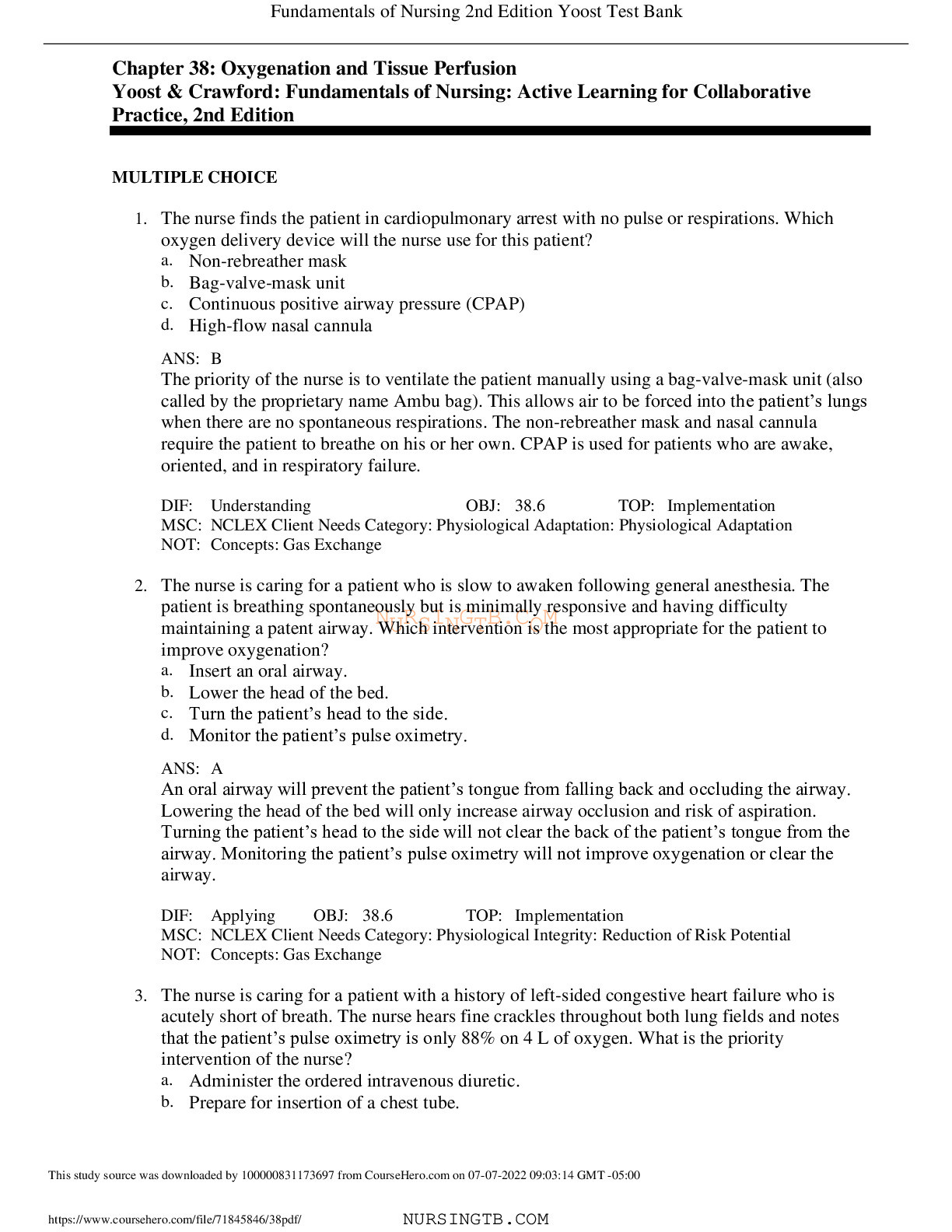All study resources > Chapter 38: Oxygenation and Tissue Perfusion Yoost & Crawford: Fundamentals of Nursing: Active Learning for Collaborative Practice, 2nd Edition (Nursing)
Chapter 38: Oxygenation and Tissue Perfusion Yoost & Crawford: Fundamentals of Nursing: Active Learning for Collaborative Practice, 2nd Edition
1. The nurse finds the patient in cardiopulmonary arrest with no pulse or respirations. Which
oxygen delivery device will the nurse use for this patient?
a. Non-rebreather mask
b. Bag-valve-mask unit
c. Continuous positive airway pressure (CPAP)
d. High-flow nasal cannula
2. The nurse is caring for a patient who is slow to awaken following general anesthesia. The
patient is breathing sp
...[Show More]
1. The nurse finds the patient in cardiopulmonary arrest with no pulse or respirations. Which
oxygen delivery device will the nurse use for this patient?
a. Non-rebreather mask
b. Bag-valve-mask unit
c. Continuous positive airway pressure (CPAP)
d. High-flow nasal cannula
2. The nurse is caring for a patient who is slow to awaken following general anesthesia. The
patient is breathing spontaneously but is minimally responsive and having difficulty
maintaining a patent airway. Which intervention is the most appropriate for the patient to
improve oxygenation?
a. Insert an oral airway.
b. Lower the head of the bed.
c. Turn the patient’s head to the side.
d. Monitor the patient’s pulse oximetry.
3. The nurse is caring for a patient with a history of left-sided congestive heart failure who is
acutely short of breath. The nurse hears fine crackles throughout both lung fields and notes
that the patient’s pulse oximetry is only 88% on 4 L of oxygen. What is the priority
intervention of the nurse?
a. Administer the ordered intravenous diuretic.
b. Prepare for insertion of a chest tube.
4. The nurse is caring for a patient who has been intubated with an oral endotracheal tube for
several weeks. The physicians predict that the patient will need to remain on a ventilator for at
least several more weeks before he will be able to maintain his airway and breathe on his own.
What procedure does the nurse anticipate will be planned for the patient to facilitate recovery?
a. Placement of a tracheostomy tube
b. Diagnostic thoracentesis
c. Pulmonary angiogram
d. Lung transplantation surgery
5. The nurse is caring for a patient with a chest tube who was transported to radiology for
testing. When the patient returns to the nursing unit, the transporter shows the nurse the
patient’s chest tube collection device, which was badly damaged after being caught in the
elevator door. What is the priority action of the nurse?
a. Clamp the chest tube until the collection device is replaced.
b. Cover the insertion site with a new occlusive dressing.
c. Ensure that there is gentle bubbling in the water seal chamber.
d. Check the patient’s lung sounds and pulse oximetry.
[Show Less]
